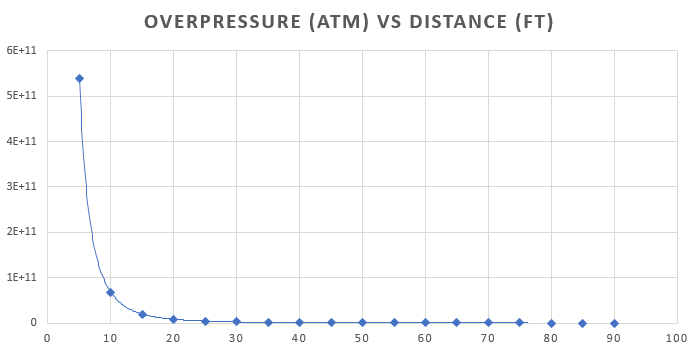This could go a number of ways, depending on how you rule it. I'll address the problems first.
What is an Object?
First and foremost, you have to consider what the definition of an Object is. The Minor Conjuration feature says...
[...]you can use your action to conjure up an inanimate object [...] no larger than 3 feet on a side and weigh no more than 10 pounds, and its form must be that of a nonmagical object that you have seen.
Herein lies the first problem. Is a blob of Fusile Hydrogen an object? Is it discrete enough that it is an 'object [he] has seen?'
The DMG (p.246) defines an Object as such:
[...]an object is a discrete, inanimate item like a window, door, sword, book, table, chair, or stone--not a building or a vehicle that is composed of many other objects.
By interpretation of this rule, no. It would not be. But, as a DM, this is still your call.
This also raises the question of "Can you conjure Part of an object, or only whole objects?" For example, could you conjure a chunk of a ship, because you've seen a ship before?
Is the Sun Magical?
In many realms, the sun is magical in nature. It's not a ball of fusing hydrogen...it's either a deity, or a hole in the fabric of the sky, or a massive portal to the Elemental Plane of Fire, or something else entirely. If the sun is magical, then he can't summon parts of it.
Assuming you're going to let this happen....
(Note: This section has been rewritten after errors in an equation I was using were pointed out to me. This altered the output of this answer dramatically)
If he summons a chunk of the sun, and assuming the sun is similar to our sun:
He can conjure a maximum of just over 30 cubic centimeters of solar core (a block about 3.1 cm to a side). This is because the Solar Core has a density of 150 grams per cubic centimeter, and Minor Conjuration can only create 10 lbs of matter (appx 4536g). This block of matter is held at a pressure of 26.5 Petapascals and a temperature of 15 million degrees C.
This seems absurd...but remember that this is a tiny piece of matter that is going to hurl itself apart the moment it is conjured (again, further evidence for it NOT being an Object). The amount of time it takes for that tiny wad of plasma to disperse would be extremely short. But, let's see what this does anyway.
While the sun's typical energy production is low (276.5 W/m3), that is still a lot of thermal energy that needs to go somewhere.
From here, it's time to break out the math. For simplicity's sake, we're going to assume the plasma behaves like an Ideal Gas. Because otherwise this gets completely insane. So, to determine the total available energy of 3ccs of solar matter, we can use this equation:
$$E = {\frac{3}{2}nRT}$$
Where E is energy, n is the number of moles of gas, R is the Gas Constant, and T is the temperature in Kelvin. At this scale, the difference between Celsius and Kelvin (273.15 degrees) is basically negligible.
At the heart of the sun, the composition is roughly 33% Hydrogen, 65% Helium, 2% Other. To determine how many moles we have, we're going to ignore the '2% other' (again, for sanity's sake) and just consider 33% Hydrogen, then just wave my hands and say the other 67% is Helium. Not strictly accurate, but close enough for my purposes.
So, starting with a total mass of 10lbs (4535.92g), we have 1496.9 grams of Hydrogen at 1.008 g/mole, and 3039 grams of Helium at 4.003 g/mole. This gives us a total of 1485 moles of Hydrogen and 759 moles of Helium. Total moles of matter: 2244
So, plugging in the numbers
$$E = 1.5 \times 2244\text{mol} \times 8.31\text{J/K} \times 150,000,000\text{K}$$
For a result of 4,195,719,000,000 Joules or 4.2 Terajoules
This is going to be a VERY large explosion. We aren't reaching the range of a nuke yet...but let's get some comparisons.
If every drop of fuel in a Boeing 747 went up at once, it would unleash 6.4 Terajoules. 12 Terajoules is what would be imparted to you if the International Space Station rammed you. 63 Terajoules (15x our drop of solar matter) was the Little Boy Atomic Bomb.
This is going to be an enormous explosion. Again, if you are permissive enough to allow that part of a star, an amorphous blob of highly dense, extremely energetic plasma, counts as an Object.
I would also mention...if you let a player conjure 'plasma' as an object...don't be surprised if they start trying to conjure up acids, toxic gases, and other amorphous substances.
But how many dice is that?
Per request of a comment, I will now attempt to render this blast in terms of dice of damage. Disclaimer: I am now applying physics to D&D rules. This segment is for entertainment purposes only (because anything caught in such a blast is dead anyway).
Tests conducted on medieval melee weapons show that a typical 1-handed swing of a Mace imparts about 130 Joules to a target. In D&D 5e, a mace deals 1d6 damage. So, to compute the dice of damage of direct exposure to the heart of a star, let's just assume damage scales linearly.
Our little spoonful of sunshine unleashed 4,195,719,000,000 Joules of energy. Divide by 130...
32,274,761,538 d6 of Fire Damage or, put simply, 32 giga-d6.

